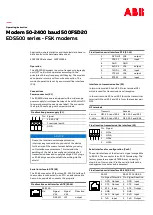
2018-02-04 | Technical improvements, changes in design, printing- and other errors expected.
5
1.2. Field of application
The EoC 1-01 modem allows feeding in of IP data signals from the Internet, for example via a router in an
existing coaxial antenna distributor, such as SAT-IF-, DVB-T, CATV- or head end distribution systems (in the
star or tree distribution).
The advantage of an ethernet solution over a coax solution is that no new network cables must be laid. The
data is transmitted through the low-attenuation return channel, frequency range of 2...68 MHz. Depending on
the quality of the coaxial cable, transmission distances of up to 700 m can be realized.
The feeding in is performed via the return channel capable terrestrial input of the SAT multiswitch, via the
terrestrial input of the antenna distributor structure or via a return channel capable antenna socket in the
distribution network.
Internet or other fed IP data are available at return channel capable antenna sockets ().
Two networkable devices can be connected to the LAN ports of a EoC modem. The IP network can be extended
to up to 64 EoC devices.
All devices connected to the EoC modems can communicate between each other. Data is exchanged, network
games are transmitted or a centralized network printer can be accessed. For the monitoring of houses, rooms
etc., an IP camera can be operated via a EoC modem.
1.2.1. Peer-to-Peer mode
The Eoc 1-01 modems communicates per default in a Peer-to-Peer mode. This means that each modem can
communicate with each modem in the network. Data is exchanged, network games are transmitted or a
centralized network printer can be accessed. For the monitoring of houses, rooms etc., an IP camera can be
operated via a EoC modem.
1.2.2. Master/Slave mode
In the master/slave mode one master device connects up to 63 slave devices with the internet. Communication
between the modems isn´t possible. The applikation in hotels or boarding houses ar typical uses of the















































